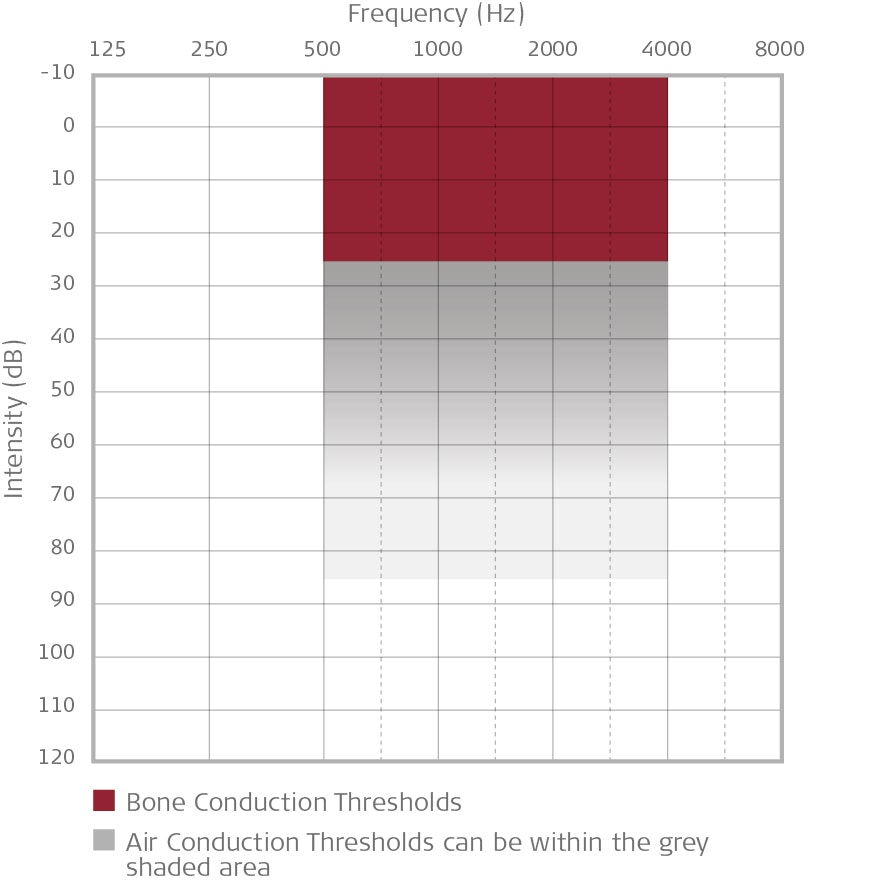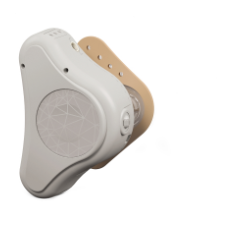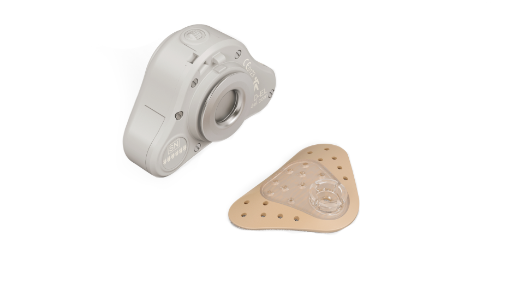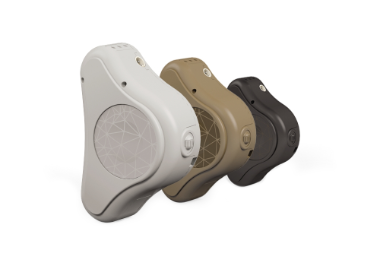Select your Language
Please, select a language for this page
Understanding Conductive Hearing Loss
What is conductive hearing loss? How will my child be able to hear if they have microtia or atresia? What are my treatment options?

If your child has conductive hearing loss, you are not alone. Conductive hearing loss is common in both children and adults. This hearing loss can be temporary or chronic and can have many different causes, such as atresia, microtia, or middle ear infections.
Thankfully, there are very effective treatment options that will make it easy for your child to hear and enjoy all the sounds of life just like any other child. Let’s look at what conductive hearing loss is and how it can be treated with comfortable and effective non-surgical solutions.

Conductive Hearing Loss
When you hear sounds, they travel from your outer ear through your middle ear to your inner ear. The outer ear “catches” sounds. The middle ear carries these sound waves as vibrations to your inner ear. Your inner ear turns these sound vibrations into nerve signals that your brain can understand as hearing.
If there is a problem with your ear canal or the tiny bones (ossicles) in your middle ear, they cannot carry the sound vibrations to your inner ear (cochlea) as well as they should.
Causes of Conductive Hearing Loss
Conductive hearing loss can have many causes. In newborns, congenital conductive hearing loss is generally caused by issues with the development of the outer or middle ear.
- Microtia (outer ear not fully developed)
- Aural Atresia (ear canal and middle ear not fully developed)
- Non-typical facial bone development (craniofacial malformation)
For children and adults, acquired conductive hearing loss can be caused by infections or disease of the middle ear. These causes can be temporary or frequently recurring/long-term issues.
- Infection of the ear canal (Chronic otitis externa)
- Middle ear infection or “glue ear” (Chronic otitis media with effusion)
- Benign middle ear tumor (Cholesteatoma)
- Damaged ossicles
- Otosclerosis
- Stenosis of the ear canal
- A hole in the eardrum (Chronic tympanic membrane perforation)
- Fluid build-up (Eustachian tube dysfunction)
- Earwax build-up (Chronic wax impaction)

Symptoms of Conductive Hearing Loss
Think of conductive hearing loss like wearing a pair of ear plugs. You might still be able to hear sounds, but they seem quieter or muffled. For your child, it may feel like people are mumbling, and their own voice may sound different. They might be able to understand conversations in quiet settings, but would get lost in busy classrooms or large groups.
To determine if your child has conductive hearing loss, you’ll need a professional hearing test. During the hearing test, your audiologist will play sounds through headphones to test your child’s hearing thresholds, which tests how well they hear different frequencies across the normal range of sounds.
The quietest tone that your child can hear at each frequency is marked on the audiogram. An audiogram is a diagram used by hearing professionals to show how well your child can hear. An audiogram can show if your child has hearing loss, what type of hearing loss your child might have, and it can help identify an appropriate hearing solution.
Haven’t had a professional hearing test? Let us know with our contact form below and we’ll help you find a specialist near you. We can also help answer any questions you have about hearing loss.
Understanding Your Audiogram
Along the top of an audiogram, a range of sound frequencies is shown. As you move from left to right on the audiogram, the frequencies increase, which means the tones become higher pitched. On the left side of the audiogram, the loudness of a sound signal is depicted. As you move from top to bottom on the audiogram, the loudness increases.
When the test tones are played through normal headphones, this is a test of your air conduction thresholds. If your child has a hearing loss, your audiologist will also likely test your child’s inner ear hearing using a special bone conduction headset. Air conduction and bone conduction threshold results are marked with different symbols on the audiogram.
If the audiogram shows hearing loss in air conduction tests, but your child has normal bone conduction hearing thresholds, this means that your child has conductive hearing loss. It can be mild, moderate, or severe conductive hearing loss.
And if you have moderate-to-severe loss in air conduction thresholds, but also a mild-to-moderate loss in bone conduction thresholds, this is called mixed hearing loss. Mixed hearing loss is a combination of conductive hearing loss and inner ear hearing loss (sensorineural hearing loss).

What if my audiogram looks different than this?
Every person’s hearing is unique, which means there are countless possibilities for audiogram results. You can also have different audiogram results for each ear, because each ear is unique.
.jpg?auto=format&sfvrsn=ea374d43_2)
Treatment for Conductive Hearing Loss
There are many different causes of conductive hearing loss, so your doctor will help you understand the best treatment options for the underlying cause of your hearing loss. But when it comes to actually being able to hear again, treating the cause may often not reverse your hearing loss.
With conductive hearing loss, traditional hearing aids are often not an effective treatment option. If the middle ear can’t carry the sound to the inner ear, only making it louder in your child’s outer ear isn’t very helpful.
Even the best hearing aids only make sounds louder from the outside, so spending extra to buy a high-power hearing aid doesn’t fix the real problem—sounds can’t clearly reach the inner ear.
Thankfully, there are very effective treatment options for conductive hearing loss. If your child’s inner ear is still healthy, you just need a way to bypass the middle ear and send sound vibrations straight to your child’s inner ear. That’s where a special type of solution comes in: bone conduction systems.
.jpg?auto=format&sfvrsn=ce374d43_2)
How Bone Conduction Hearing Systems Work
Your inner ear sits in a section of the solid bone of your head called the temporal bone, which is located right under the skin around your outer ear. If you send sound vibrations through this bone, they reach your inner ear and are heard just like normal sounds. You can try this by tapping the side of your head or putting a tuning fork against your skin.
A bone conduction system uses tiny mechanical vibrations to send sound vibrations to your inner ear. A small audio processor uses microphones and a mechanical transducer to instantly turn sounds into amplified vibrations. These sound vibrations travel through the skin to the inner ear and become hearing.

How ADHEAR Restores Hearing
The unique ADHEAR bone conduction system from MED-EL is a new type of bone conduction hearing technology. What makes ADHEAR unique is that it uses no-pressure adhesive pads to attach to the skin behind your child’s ear. The sound vibrations are sent from the compact ADHEAR audio processor to the adhesive pad. This allows ADHEAR to provide very effective bone conduction hearing without the need for surgery or a tight headband.

ADHEAR is so exciting because there is no need for surgery and the hearing benefit is immediate. To use ADHEAR, you simply apply the adhesive pad behind your child’s ear, then snap ADHEAR onto the pad. Stick, click, hear: It’s really that easy.
What sets ADHEAR apart from other bone conduction hearing aids? Traditional non-surgical bone conduction systems, such as the BAHA SoundArc or SoftBand, can provide good sound amplification, but they require high pressure against the skin to transmit the sound to the bone. This pressure can be very uncomfortable and may make it difficult to wear these devices for a full day. Similar problems exist for bone conduction glasses and other traditional bone conduction hearing aids.
With ADHEAR, there is no painful pressure, because the unique adhesive design rests gently on the skin. There is also no compromise in performance for this benefit, because ADHEAR is very effective at transmitting sounds to the inner ear. ADHEAR has been proven to provide equivalent hearing to softbands or hardbands.1, 2
1. J. Gavilan, Comparison of the non-invasive adhesive bone conduction hearing system with passive transcutaneous bone conduction implants in children with Atresia and Microtia, ESPCI Bucharest, Romania (2019)
2. P.H. Skarzynski, A. Ratuszniak, K. Osinska, M. Koziel, B. Krol, K.B. Cywka, H. Skarzynski, A Comparative Study of a Novel Adhesive Bone Conduction Device and Conventional Treatment Options for Conductive Hearing Loss, Otol Neurotol, 7 (2019) 858-864
.jpg?auto=format&sfvrsn=e3374d43_2)
All-Day Comfort
ADHEAR is an ideal bone conduction solution for children, because it is very comfortable to wear and offers a discreet wearing option. ADHEAR is worn comfortably behind the ear, and doesn’t require a headband or other bulky equipment.
You can take ADHEAR off the adhesive pad when your child goes to bed and put it back on when your child wakes up. For convenience, you can even leave the adhesive pads on while your child showers or swims. You simply replace the adhesive pads every 3-7 days as needed.

.jpg?auto=format&sfvrsn=e2374d43_2)
Trying Out ADHEAR
With the simple adhesive design, your child can test out ADHEAR and experience the benefits immediately. There is no need for surgery or a complicated fitting session. ADHEAR is pre-programmed and ready to use. It has built-in volume control dial, so you just put it on and adjust to the level your child needs for comfortable listening.
To test out the benefits of ADHEAR, you simply need to visit an ADHEAR provider and ask to test ADHEAR. This hearing trial only takes a few minutes and makes it easy to know if ADHEAR is the right solution for your child.
1
Visit a local ADHEAR provider, such as an approved hearing aid retailer. Our team can help you locate the most convenient provider for you.
2
Try out hearing with ADHEAR during the visit to the ADHEAR provider. This simple trial will let your child experience the benefits of ADHEAR right away.
3
Watch your child enjoy hearing with ADHEAR in daily life, at school, on the playground, and more.

What is the price of ADHEAR? This depends on many factors, including your local healthcare system and the reimbursement policies for your specific case. If you’d like more information on costs of ADHEAR, you can contact our reimbursement support team through our contact form below. We’ll help you understand what funding is available based on your particular situation.
If you’d like help finding an expert ADHEAR provider near you, please let us know with our contact form. We will happily connect you to one of our local care providers.

Here With You
At MED-EL, we’ve been connecting families with life-changing hearing implants for more than 30 years so we understand that hearing loss can be difficult for you and your whole family. That’s why we’ve always been driven by one thing: A passion to help people with hearing loss.
It’s been that way since 1977, when our CEO, Dr. Ingeborg Hochmair, pioneered the modern cochlear implant along with her husband Erwin. Today we’ve grown to more than 3,100 employees covering 137 countries, but we’re still guided by the steadfast principles of our founders.
Our dedicated support network and local care specialists ensure our recipients are always well cared for. And when we create new technology, we make sure it’s compatible with earlier implants so that everyone can benefit. With MED-EL, our recipients know they can always count on us for a lifetime of better hearing.
When you’re ready to take the next step, we’ll be here with you every step of the way.


